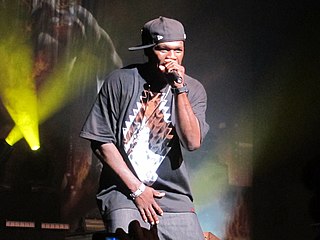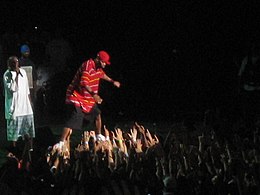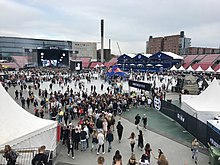
Rapping is an artistic form of vocal delivery and emotive expression that incorporates "rhyme, rhythmic speech, and [commonly] street vernacular". It is usually performed over a backing beat or musical accompaniment. The components of rap include "content", "flow", and "delivery". Rap differs from spoken-word poetry in that it is usually performed off-time to musical accompaniment. It also differs from singing, which varies in pitch and does not always include words. Because they do not rely on pitch inflection, some rap artists may play with timbre or other vocal qualities. Rap is a primary ingredient of hip hop music, and so commonly associated with the genre that it is sometimes called "rap music".

Toasting or deejaying is the act of talking, usually in a monotone melody, over a rhythm or beat by a deejay. It can either be improvised or pre-written. Toasting developed in Jamaica, before it took up that name and being part of the sound system era, a similar sound of it is found in mento and now can be heard over musical styles including ska, reggae, dancehall, dub, grime, hip hop, soca and bouyon music. The combination of singing and toasting is known as singjaying.
The music of Finland can be roughly divided into folk music, classical and contemporary art music, and contemporary popular music.

Azerbaijani music is the musical tradition of the Azerbaijani people from Azerbaijan Republic. Azerbaijani music has evolved under the badge of monody, producing rhythmically diverse melodies. Music from Azerbaijan has a branch mode system, where chromatisation of major and minor scales is of great importance.
The music of Malawi has historically been influenced by its triple cultural heritage of British, African, and American music. Malawians, known for their history as travellers and migrant workers, have contributed to the spread of their music across the African continent, blending it with various musical forms. A significant factor in this musical amalgamation was World War II, during which soldiers transported music to distant lands and brought it back, leading to the popularity of guitar and banjo duos as dance bands by the war's end. Both instruments were imported. Additionally, Malawians working in mines in South Africa and Mozambique influenced the fusion of music styles, giving rise to genres such as Kwela.
Electro is a genre of electronic music and early hip hop directly influenced by the use of the Roland TR-808 drum machines and funk. Records in the genre typically feature heavy electronic sounds, usually without vocals; if vocals are present, they are delivered in a deadpan manner, often through electronic distortion such as vocoding and talkboxing. It palpably deviates from its predecessor boogie by being less vocal-oriented and more focused on electronic beats produced by drum machines.
There are several subgenres of reggae music including various predecessors to the form.
Celtic fusion is an umbrella term for any modern music which incorporates influences considered "Celtic", or Celtic music which incorporates modern music. It is a syncretic musical tradition which borrows freely from the perceived "Celtic" musical traditions of all the Celtic nations, as well as from all styles of popular music, it is thus sometimes associated with the Pan-Celtic movement. Celtic fusion may or may not include authentic traditional music from any one tradition under the Celtic umbrella, but its common characteristic is the inspiration by Celtic identity.
A music genre is a conventional category that identifies some pieces of music as belonging to a shared tradition or set of conventions. Genre is to be distinguished from musical form and musical style, although in practice these terms are sometimes used interchangeably.
The Gambian hip hop scene is a relatively new scene in African hip hop which developed in the mid-1990s and was heavily influenced by American hip hop and Senegalese hip hop. Gambian hip-hop has been heavily influenced by international music scene including worldbeat, Senegalese wolof music, and American hip hop, as well as traditional Gambian mbalax and n'daga music. Dominican merengue and Jamaican reggae, ragga, and dancehall have also influenced the development of Gambian hip-hop.
Hip hop or hip-hop, also known as rap and formerly as disco rap, is a genre of popular music that originated in the early 1970s from the African American community, with notable contributions from Latinos and Caribbean immigrants. Hip-hop music originated as an anti-drug and anti-violence genre consisting of stylized rhythmic music that often accompanies rapping, a rhythmic delivery of poetic speech. In the early 1990s, a professor of African American studies at Temple University said, "Hip-hop is something that blacks can unequivocally claim as their own." By the 21st century, the field of rappers had diversified by both race and gender. The music developed as part of the broader hip-hop culture, a subculture defined by four key stylistic elements: MCing/rapping, DJing/scratching with turntables, breakdancing, and graffiti art. While often used to refer solely to rapping and rap music, "hip hop" more properly denotes the practice of the entire subculture. The term hip hop music is sometimes used synonymously with the term rap music, though rapping is not a required component of hip hop music; the genre may also incorporate other elements of the culture, including DJing, turntablism, scratching, beatboxing, and instrumental tracks.
This is a list of lists of musicians.
The State of New York is a major center for all types of music. Its diverse community has contributed to introducing and spreading many genres of music, including salsa, jazz, folk, rock and roll, and classical. New York's plethora of music venues and event halls serve as popular markers which have housed many noteworthy artists.
Music and Black liberation refers to music associated with Black political movements for emancipation, civil rights, or self-determination. The connection between music and politics has been used in many cultures and was utilized by blacks in their struggle for freedom and civil rights. Music has been used by African Americans over the course of United States history to express feelings of struggle and hope, as well as to foster a sense of solidarity to aid their fight for liberation and justice. African Americans have used music as a way to express their struggle for freedom and equality which has spanned the history of the United States which has resulted in the creation and popularization of many music genres including, jazz, funk, disco, rap, and hip hop. Many of these songs and artists played pivotal roles in generating support for the civil rights movement.










